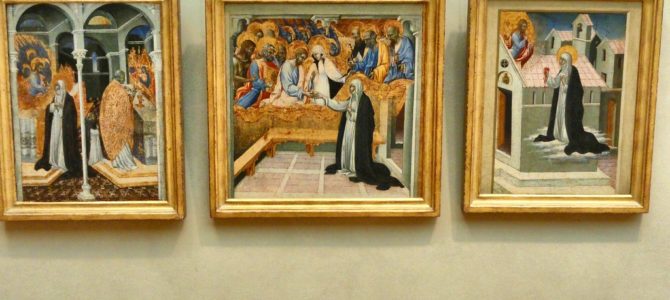
Two years ago, The Job Network and USA Today featured a top 10 list of qualities of “successful and creative women.” The traits included assertiveness, empathy, passion, imperfection, power, faith, adaptability, courage, self-care, and gratitude.
Presumably meant as a blueprint for feminist triumph, there are far better examples of “successful and creative women” than Elizabeth Warren or Kamala Harris. One is the philosopher and theologian St. Catherine of Siena, whose feast day the Catholic Church celebrates today.
Catherine, born in 1347, was the daughter of a local poet and Giacomo di Benincasa, a cloth-dyer. She was reportedly so happy as a child that the family gave her the pet name “Euphrosyne”—Greek for “joy.” She was also unusually pious for a little girl. She had a vision of Christ when she was only five or six years old.
By age seven, Catherine vowed to offer her life to God. She demonstrated remarkable courage, stubbornly refusing to marry as her parents wished later on. She instead asserted her intention to consecrate herself to Christ and remain celibate for life. She eventually became a Dominican tertiary—a laywoman attached to one of the most popular and influential religious orders of the Middle Ages, which counts among its ranks St. Thomas Aquinas.
She experienced more mystical visions of Christ in her early twenties, but was known for more than her spirituality. Driven by necessity, she entered into the social and political tensions of the time. She began traveling throughout northern and central Italy, urging reform of the clergy and calling on people to repent. She persuaded an Italian city to end its opposition to the papacy. She promoted a new crusade.
Before long, Catherine was engaged in a long correspondence with Pope Gregory XI, pressing him to reform the clergy and the corrupt governance of the Papal States (the papacy at the time controlled a significant chunk of central Italy). In 1376 she traveled to Avignon, France—where the pope at the time resided—as ambassador of the Republic of Florence.
Catherine also sought to convince Gregory XI to return the papacy to rightful home in Rome, as the papacy had moved to France in 1307, largely because of the unruly mob violence endemic to central Italy. Perhaps Catherine had some influence on Gregory, who returned to Rome in 1377.
Catherine later founded an Italian monastery, known for its particularly strict observances. She was nearly assassinated while serving on another diplomatic mission in 1378. She wrote works of great theological insight, including “The Dialogue of Divine Providence.” More than 300 of her letters and 26 of her prayers survived, now treasured by scholars. She died on April 29, 1380, at age 33.
No one could accuse Catherine of lacking assertiveness, passion, power, adaptability, or courage. To do what she did both religiously and politically, as a woman in the 14th century, was an unparalleled accomplishment. She had incredible faith—not in herself, as popular secular psychology encourages us—but in an omnipotent, all-loving God who would guide and enable her to fulfill her many missions on earth. Catherine’s last words were “Father, into your hands I commend my soul and my spirit.” Miracles were reported at her grave not long after her death, and she was declared a saint by the Catholic Church in 1461.
The Catholic Church has recognized not only her saintliness, but her intellectual acuity. Pope Paul VI declared her a doctor of the church in 1970. There are only 36 persons thus honored, a title reserved for those deemed to have had a particularly significant influence on theology and doctrine. She affected Catholic doctrine on mysticism, suffering, the Eucharist, and the role of the papacy.
Pope Benedict XVI acknowledged this in a 2010 homily, quoting her exhortation: “Remember Christ crucified, God and man … Make your aim the Crucified Christ, hide in the wounds of the Crucified Christ and drown in the blood of the Crucified Christ.” She is also famous for her analogy of Christ as a bridge between heaven and earth. In 1999, Pope John Paul II named her one of the six patron saints of Europe, because of her influence and travels across Europe on behalf of the church.
Catherine of Siena accomplished a remarkable amount for such a short life (the same number of years Jesus likely lived). Her accomplishments span literature, politics, and theology, yet she can hardly be termed a progressive. She was a defender of orthodox, biblical Christianity, as well as the hierarchy of the church.
Although she held positions of authority quite rare for her time, she was a defender of traditional institutions. As such, she defies what contemporary culture thinks of when it imagines a woman with the qualities lauded by mainstream media.
Perhaps, contrary to what we’ve been told, there are other waysbesides a fierce, atomistic drive for professional power and affluence to exemplify feminine strength and virtue. St. Catherine of Siena points us to one such woman of whom it can be truly said “nevertheless, she persisted.”









